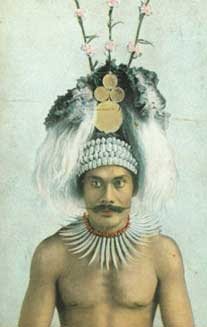Tribes, Chiefdoms, and Redistributive Exchange
As indicated in Chapt. 10 of text, and in the lesson on Horticultural Mode of Production, tribes and chiefdoms are the two forms of socio/political organization found in horticultural and pastoral modes of production. The political leaders of tribes and chiefdoms, big men and chiefs respectively, are both involved in a new method of exchange which seems essential to these modes of production, redistributive exchange.
Horticultural and Pastoral societies, whether tribes or chiefdoms, continued to exchange most resources and goods via reciprocal exchange (usually balanced reciprocity). Added to reciprocal exchange was another form which most anthropologists call redistributive exchange. In redistributive exchange, a political center or head collects goods and resources which he then redistributes. This is presented in a graphic form below:

If the culture is tribal in its organization (such as the Yanomamo, the Nuer, and to some extent the traditional Hmong) the political center is a big man, and everything collected is redistributed. As a result, the big man if anything has less than anyone else, and the result is to redistribute goods and resources in a more equal way than they were originally. This is called egalitarian redistributive exchange. As indicated in the previous lesson, big men are often viewed as intensifiers of production, since they persuade people to work harder and longer (and produce more food) in order to initially contribute more to the big man. Competing big men put on feasts for each others group, and the group that gives away the most food and the most goods gains prestige.
If the culture is organized as a chiefdom, the political center is a chief, and the chief retains part of what is collected, often to support his own followers at a higher level than is true of the population generally. When chiefs redistribute, the effect is therefore not egalitarian: some people definitely end up with more than others. This is called stratified redistribution, and is characteristic not only of chiefdoms but of intensive agriculture and industrialism. (All taxes in our industrial culture are a form of stratified redistributive exchange.) Chiefdoms developed in some areas out of horticultural tribes. Some anthropologists have noted that chiefdoms essentially manipulated the system of redistributive exchange in order to gain true authority and power, and then used that power to further intensify production. This enabled the chiefdom to provide food for more people, though those people had to worker harder than ever, and were now literally subject to the chief.
 
As you read about the Nuer and the traditional Hmong, think about how authority, resources, and goods are distributed in these cultures. Were both groups essentially egalitarian and hence tribal?
|